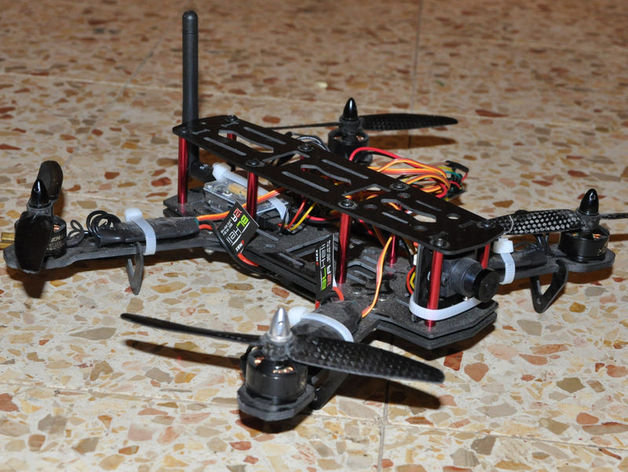
QAV250 Cheap Racing FPV Quadcopter
thingiverse
The FPV racing quadcopter is one of the most exhilarating experiences you can have with RC Toys. This instructable will explain how you can build your own 250-class racing quadcopter, complete with a state-of-the-art FPV system that lets you see through the eyes of your drone. Parts for the Quadcopter: * Frame: Qav250 carbon fiber racing frame, precision-engineered for maximum stability and performance. * Motors: 4 high-torque EMAX MT1806 KV2280 brushless motors, capable of producing incredible speeds. * Propellers: High-efficiency CF 5040 propellers, designed to maximize thrust and minimize drag. * ESC: 4 advanced SimonK Series 12A ESCs, featuring robust current handling and lightning-fast response times. * Flight Controller: Cutting-edge CC3D flight controller, optimized for exceptional stability and responsiveness. * Battery: High-capacity 3S 1500mAh LiPo battery, providing up to 15 minutes of non-stop flight time. Parts for the FPV System: * Battery: Powerful 2200mAh 11.1V LiPo battery, capable of powering goggles for up to 5 hours. * Transmitter: Boscam FPV 5.8G 200mW AV Wireless Transmitter, featuring crystal-clear video transmission and rock-steady stability. * Receiver: High-sensitivity 200mW AV Wireless-Receiver, ensuring seamless video reception and maximum image quality. * Monitor: Large 4.3-inch TFT display, providing a clear and immersive viewing experience. Camera: * Micro CCD camera, delivering high-resolution images and rapid frame rates for unparalleled FPV performance. FPV Goggles: * Alternatively, you can use the custom-designed fpv goggles that I've shared on Thingiverse, perfect for immersive FPV experiences. Designing This Quadcopter: Building the Quadcopter The first step in building your quadcopter is assembling the frame. Simply follow the instructions provided with the Qav250 carbon fiber racing frame and construct the chassis according to the manufacturer's guidelines. Motor Installation Your quadcopter features four motors, two CW and two CCW. To install them correctly, follow this sequence: * Front left arm: CW motor * Front right arm: CCW motor * Rear left arm: CCW motor * Rear right motor: CW motor When connecting the wires to the arm of the chassis, make sure they are securely attached and will not interfere with the motor's rotation. ESC Wiring Each ESC has five wires and a plug. Connect the three black wires to the motors according to the manufacturer's instructions: * CW rotation: connect the wires straight from the ESC to the motor (first ESC wire to first motor wire, second wire to second wire, third wire to third wire). * CCW rotation: simply swap the connections between the second and third wire. Once you've made all the connections with solder, plug in the T-plug red wire and black wires together. Then, connect the flight controller according to the following sequence: * Connect the motor output 1 to the front left ESC * Connect the motor output 2 to the front right ESC * Connect the motor output 3 to the rear left ESC * Connect the motor output 4 to the rear right ESC Flight Controller Installation Connect the 2.4GHz receiver to the CC3D flight controller by plugging in the connections from the receiver's output to the CC3D inputs (channel 1 to input 1, channel 2 to input 2, etc.). Make sure you connect at least six channels. Wiring Complete! Once you've finished wiring your quadcopter, update the CC3D firmware and perform a calibration. The CC3D flight controller works seamlessly with the open-source OpenPilot program. To install OpenPilot on your PC, download the software and follow the instructions provided in the UI. Make sure to complete all necessary steps to ensure a smooth installation process.
With this file you will be able to print QAV250 Cheap Racing FPV Quadcopter with your 3D printer. Click on the button and save the file on your computer to work, edit or customize your design. You can also find more 3D designs for printers on QAV250 Cheap Racing FPV Quadcopter.
